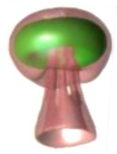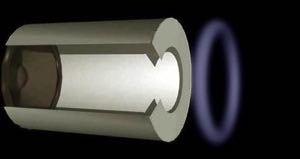Most smokers (cough) can blow a smoke ring (or toroid or ring-vortex) by making a quick pressure change in their mouth. I plan to use a chemically-correct mixture of acletyine and oxygen instead of smoke (it burns better) just to see what happens when I light it.
I suppose I could suck on a cigarette lighter and use my mouth and blow a 'smoke gas ring' and then light it with a cigarette lighter... but if Giles Smith wouldn't do it, then I'm not going to either.
Below, a 3-inch speaker supplies the pressure pulse at one end of a chamber and, with various pulse-widths, rates, I can create a nice stable torus.
Here you can see a 3D graphic cut-away view of the inside of the 10cm vortex launching chamber. The speaker cone is to the left and the ring vortex leaves the chamber to the right.
Soon a torus of highly flamable gas will then be ignited (actually, detonated) using a spark between two thin wires about 3 inches from the output of the chamber. (I must be careful not to ignite the contents of the generator - that would NOT be good)
The torus of spinning, burning, moving gas will of course get considerably larger than it was before ignition and, due to the ignition starting at only one point on the torus, it may become distorted and turn toward me!
OK, so this one's a bit dangerous - but what an interesting weapon. A cross between a flame-thrower, a laser and a repulsion-beam. Could this be used for propulsion? Perhaps.
UPDATE:
Well, I've been able to freeze-frame their creation/birth from the chamber. (The strobe works great.) I've experimented with various size rings. Unfortunately the small high speed ones don't go very far. Actually, it's very difficult to create a high-speed (spin) vortex. They just don't seem to form properley :-\
While I have set fire to a torus of gas, I still haven't detonated one. Looks cool.
Problem: When they ignite, the flame has two effects:
1) Flame flash-back into the generating chamber... (woof!)
2) Destruction of the vortex due to the turbulance left from creating them ... (POOF!)
Hmmm, before I detonate one, I need to make sure flash-back either doesn't occur or is minimised.
Catch-22: A smaller chamber would minimise any potential damage from flying shrapnel by reducing the size of the explosion. However, reducing the size of the chamber also reduces the size of the ring-vortex. Small vortex dont persist long enough before breaking-up, so I'd have to ignite them sooner, thereby increasing the chance of 'flash-back' as they are be closer to the chamber when ignited.
Perhaps the safest way is to make a HUGE vortex. Now where's that old 18" speaker and a garbage can. (Thanks Bill Beaty.)
Due to an email from a chap who worked-out the energy released in a detonation of Acetylene and oxygen I have decided not to pursue this experiment. Too dangerous.
Project cancelled.

